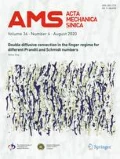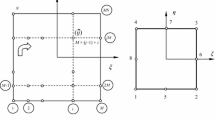Abstract
Formulation and numerical evaluation of a novel twice-interpolation finite element method (TFEM) is presented for solid mechanics problems. In this method, the trial function for Galerkin weak form is constructed through two stages of consecutive interpolation. The primary interpolation follows exactly the same procedure of standard FEM and is further reproduced according to both nodal values and averaged nodal gradients obtained from primary interpolation. The trial functions thus constructed have continuous nodal gradients and contain higher order polynomial without increasing total freedoms. Several benchmark examples and a real dam problem are used to examine the TFEM in terms of accuracy and convergence. Compared with standard FEM, TFEM can achieve significantly better accuracy and higher convergence rate, and the continuous nodal stress can be obtained without any smoothing operation. It is also found that TFEM is insensitive to the quality of the elemental mesh. In addition, the present TFEM can treat the incompressible material without any modification.
Similar content being viewed by others
References
Zienkiewicz O.C., Taylor R.L.: The Finite Element Method. 5th edn. Butterworth Heinemann, Oxford (2000)
Reddy J.N.: An Introduction to Nonlinear Finite Element Analysis. Oxford Univeristy Press, Oxford (2004)
Dohrmann C.R., Heinstein M.W., Jung J., Key S.W., Witkowski W.R.: Node-based uniform strain elements for three-node triangular and four-node tetrahedral meshes. Int. J. Numer. Meth. Eng. 47, 1549–1568 (2000)
Smith I.M., Griffiths D.V.: Programming the Finite Element Method, 4th edn. Wiley, Hoboken (2004)
Lee N.S., Bathe K.J.: Effects of element distortions on the performance of isoparametric elements. Int. J. Numer. Meth. Eng. 36, 3553–3576 (1993)
Hughes T.J.R.: The Finite Element Method: Linear Static and Dynamic Finite Element Analysis. Prentice-Hall, Englewood Cliffs (1987)
Hughes T.J.R.: Equivalence of finite elements for nearly incompressible elasticity. J. Appl. Mech. 44, 181–183 (1977)
Bonet J., Burton A.J.: A simple average nodal pressure tetrahedral element for incompressible and nearly incompressible dynamic explicit applications. Comm. Numer. Meth. Eng. 14, 437–449 (1998)
Lucy L.B.: A numerical approach to testing of the fission hypothesis. Astron. J. 82, 1013–1024 (1977)
Belytschko T., Lu Y.Y., Gu L.: Element-free Galerkin method. Int. J. Numer. Meth. Eng. 37, 229–256 (1994)
Liu W.K., Jun S., Zhang Y.F.: Reproducing kernel particle methods. Int. J. Numer. Meth. Eng. 20, 1081–1106 (1995)
Atluri S.N., Zhu T.: A new meshless local Petrov–Galerkin (MLPG) approach in computational mechanics. Comput. Mech. 22, 117–127 (1998)
Zheng, C., Wu, S.C., Tang, X.H., Zhang, J.H.: A novel mesh-free poly-cell Galerkin (MPG) method. Acta Mech. Sin. doi:10.1007/s10409-009-0239-5
Zheng C., Wu S.C., Tang X.H., Zhang J.H.: A meshfree poly-cell Galerkin (MPG) approach for elasticity and fracture problems. Comp. Modell. Eng. Sci. 38, 149–178 (2008)
Dolbow J., Belytschko T.: Volumetric locking in the element free Galerkin method. Int. J. Numer. Methods Eng. 46, 925–942 (1999)
Puso M.A., Chen J.S., Zywicz E., Elmer W.: Meshfree and finite element nodal integration methods. Int. J. Numer. Meth. Eng. 74, 416–446 (2008)
Liu G.R., Zhang G.Y.: Upper bound solution to elasticity problems: a unique property of the linearly conforming point interpolation method (LC-PIM). Int. J. Numer. Meth. Eng. 74, 1128–1161 (2008)
Timoshenko S.P., Goodier J.N.: Theory of Elasticity, 3rd edn. McGraw-Hill, New York (1970)
Roark R.J., Young W.C.: Formulas for Stress and Strain. McGraw-Hill, New York (1975)
Author information
Authors and Affiliations
Corresponding author
Additional information
The project supported by the National Natural Science Foundation of China (50474053, 50475134 and 50675081) and the 863 project (2007AA042142).
Rights and permissions
About this article
Cite this article
Zheng, C., Wu, S.C., Tang, X.H. et al. A novel twice-interpolation finite element method for solid mechanics problems. Acta Mech Sin 26, 265–278 (2010). https://doi.org/10.1007/s10409-009-0265-3
Received:
Revised:
Accepted:
Published:
Issue Date:
DOI: https://doi.org/10.1007/s10409-009-0265-3




